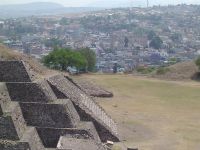Tula de Allende (Otomi: Mameni) is a town and one of the 84 municipalities of Hidalgo in central-eastern Mexico. The municipality covers an area of 305.8 km2 (118.07 sq mi), and as of 2010, the municipality had a total population of 103,919. The municipality includes numerous smaller outlying towns, the largest of which are El Llano, San Marcos, and San Miguel Vindho. It is a regional economic center and one of Mexico's fastest growing cities. However, it is best known as the home of the Tula archeological site, noted for its Atlantean figures. Its built-up area (or metro) made up of Atotonilco de Tula, Atitalaquia, Tlaxcoapan municipalities was home to 188,659 inhabitants at the 2010 census.
History
The name is derived from the Nahuatl phrase Tollan-Xicocotitlan, which means near where cattails grow. Tula is the Hispanicized pronunciation of Tollan. In Otomi the area is called Namehi, which means “place of many people.” It was given the appendage of “de Allende” in honor of Ignacio Allende who fought in the Mexican War of Independence.
The area was the capital of one of the major civilizations of Mesoamerica, that of the Toltecs. The Toltecs rose to power after 713 CE as the successor to Teotihuacan. The current city is centered just south of the ceremonial center of the ancient city, which is famous for its Atlantean figures. The Toltec Empire reached as far south as the Valley of Mexico and its influence has been found in artifacts as far away as the current U.S. Southwest. It is believed that aguamiel was first extracted around 1100CE, which led to the making of pulque. The last Toltec ruler was Topilzin Ce-Acatl Quetzalcoatl who came to power in 1085.
According to the Codex Mendoza, the site was conquered under the reign of Tizoc and subsequently incorporated into the Aztec Empire
After the Spanish conquest of the Aztec Empire, Pedro Miahuazochil was named in 1531 as the lord of Tula helping to evangelize the area.
Tula became a municipality in 1871.
The Tula
